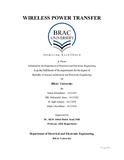| dc.contributor.advisor | Azad, Dr. AKM Abdul Malek | |
| dc.contributor.author | Khandaker, Tahsin | |
| dc.contributor.author | Alam, MD. Mahmudul | |
| dc.contributor.author | Zaheen, M. Sajib | |
| dc.contributor.author | Chowdhury, Dipta | |
| dc.date.accessioned | 2018-05-08T03:51:14Z | |
| dc.date.available | 2018-05-08T03:51:14Z | |
| dc.date.copyright | 2018 | |
| dc.date.issued | 2018 | |
| dc.identifier.other | ID 13221037 | |
| dc.identifier.other | ID 14121022 | |
| dc.identifier.other | ID 14121079 | |
| dc.identifier.other | ID 14121074 | |
| dc.identifier.uri | http://hdl.handle.net/10361/9976 | |
| dc.description | This thesis is submitted in partial fulfilment of the requirements for the degree of Bachelor of Science in Electrical and Electronic Engineering, 2018. | en_US |
| dc.description | Catalogued from PDF version of thesis. | |
| dc.description | Includes bibliographical references (page 101-105). | |
| dc.description.abstract | Electric vehicles are making a new era in the world of vehicles and electronics where
Bangladesh has just started getting the touch of this technology. It is very efficient and a way of
saving our natural resources aiming to modernize these fuel free transports of Bangladesh. This
paper is about a wireless charging system for EV and solar vehicles. The purpose of this project
is designing and implementation of a system to enhance the performance of wireless power
transfer system and to reduce the use of wires by using a Tesla coil as a transmitter to produce
high frequency, high voltage with low alternating current in order to produce high density flux to
transfer electric power. Power is transferred wirelessly by magnetic field which is created by
direct induction followed by resonant magnetic induction which is a form of inductive coupling
where the carried flux can be captured by inductive coil at the receiver that coupled to the
primary coil. This tesla coil is involved to transfer power at a distance to a load or an electrical
equipment that need to be charged or powered wirelessly. This system is developed so as to
reduce the use of wire, save natural resources, on going power for electric vehicle and wireless
charging. As a core factor, charging for solar vehicle is also mentioned. | en_US |
| dc.description.statementofresponsibility | Tahsin Khandaker | |
| dc.description.statementofresponsibility | MD. Mahmudul Alam | |
| dc.description.statementofresponsibility | M. Sajib Zaheen | |
| dc.description.statementofresponsibility | Dipta Chowdhury | |
| dc.format.extent | 136 pages | |
| dc.language.iso | en | en_US |
| dc.publisher | BRAC Univeristy | en_US |
| dc.rights | BRAC University theses are protected by copyright. They may be viewed from this source for any purpose, but reproduction or distribution in any format is prohibited without written permission. | |
| dc.subject | Power transfer | en_US |
| dc.subject | Wireless power transfer | en_US |
| dc.title | Wireless power transfer | en_US |
| dc.type | Thesis | en_US |
| dc.contributor.department | Department of Electrical and Electronic Engineering, BRAC University | |
| dc.description.degree | B. Electrical and Electronic Engineering | |

